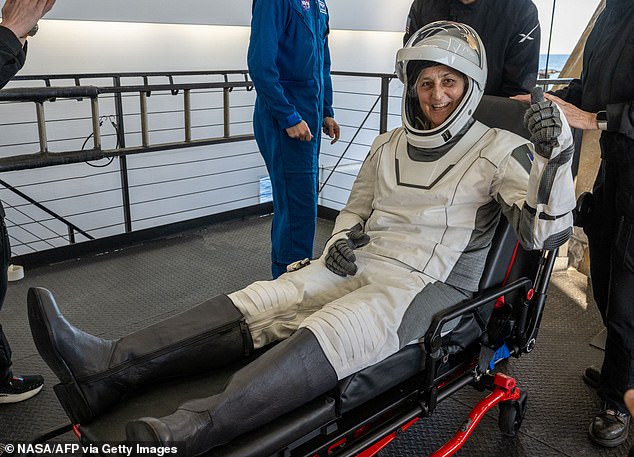
Astronauts Butch Wilmore and Suni Williams Carried After Nine-Month Space Mission Return
NASA Astronauts Return After Nine Months in Space—Recovery Challenges Ahead
(Images included throughout highlight key moments and health impacts)
NASA astronauts Suni Williams and Butch Wilmore have returned to Earth following a grueling nine-month stay aboard the International Space Station (ISS). The duo, initially scheduled for an eight-day mission, faced extended delays due to technical failures with Boeing’s Starliner spacecraft. Their eventual return via SpaceX’s Crew Dragon capsule marked the end of a 286-day ordeal, but their journey to full recovery is just beginning.
Immediate Health Concerns
Dramatic footage showed Williams and Wilmore being carried out of the capsule on stretchers after landing off Florida’s coast. Prolonged exposure to microgravity severely weakens muscles and bones, akin to months of bed rest. NASA astronauts Nick Hague and Russian cosmonaut Aleksandr Gorbunov, who accompanied them, also required assistance. All four underwent medical evaluations before heading to Houston’s Johnson Space Center.
(Image: Williams and Wilmore assisted onto stretchers post-landing, highlighting their physical state.)
Surprisingly, within hours, the astronauts were seen walking with support upon arrival in Houston. Williams, frail and still connected to an IV drip, and a clean-shaven Wilmore managed brief movements—a promising yet tentative start to their recovery.
Why Space Weakens the Body
In microgravity, bodily fluids shift toward the head, disrupting balance and reducing blood volume by 10%. Upon return, this fluid redistribution triggers dizziness and low blood pressure. In 2006, astronaut Heidemarie Stefanyshyn-Piper collapsed twice during a press conference after just 12 days in space. “Boy, if that’s not a little embarrassing,” she joked mid-fainting spell—a stark reminder of the body’s vulnerability.
(Image: Stefanyshyn-Piper collapsing during her 2006 briefing, illustrating post-spaceflight risks.)
Muscle and bone loss pose greater long-term risks. Studies reveal astronauts lose 20% of muscle mass monthly in space, particularly in legs critical for walking. Bone density drops 1-2% per month, raising fracture risks. A 2020 study found some astronauts never fully regain lost bone mass, with Mars mission simulations suggesting a third could develop osteoporosis.
The Road to Recovery
NASA’s 45-day rehab program focuses on rebuilding strength. Phase one includes gait training and mobility exercises. Phase two introduces balance and cardiovascular workouts, while phase three aims to restore peak performance. However, recovery is slow. After a six-month mission, one ESA astronaut still showed deficits post-rehab. Dr. Vinay Gupta, a pulmonologist, notes, “You’ll see decreased muscle mass and strength—no question.”
(Image: Astronaut Raja Chari in rehab post-mission, demonstrating recovery exercises.)
Williams and Wilmore’s path mirrors fellow astronaut Frank Rubio, who needed assistance after a U.S.-record 371 days in space. Their ability to walk shortly after landing surprised experts, but their wrists appeared notably thin—a visual clue to skeletal strain.
Lessons for the Future
Extended missions, like potential Mars voyages, magnify these risks. Researchers warn three-year journeys could devastate bone health. While Williams and Wilmore’s journey ended, their recovery underscores the urgency of solving space’s physical toll—a hurdle for humanity’s interplanetary ambitions.
(Image: Crew Dragon docks with ISS—symbolizing both triumph and the challenges ahead.)
For now, the astronauts face months of therapy. As Gupta summarizes: “They’ve done all the right things, but space spares no one.” Their story is a testament to resilience—and a cautionary tale for the stars.
Word count: ~600


